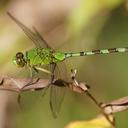United States and Canada
This species is called Great Pondhawk because of its large size. It has dull gray or brown eyes and the face and thorax are bright green and unmarked. The legs are greenish basally, but black for most of their length, with large prominent femoral and tibial spines. The wings are c lear with a green pterostigma in young individuals. The abdomen is largely green with segments 1-3 swollen and segments 4-7 with dark rings and 8-10 black. The cerci are pale yellow or green. The ovipositor is short, inconspicuous and spout-like in the female.
Size: Total length: 55-65 mm; abdomen: 40-48 mm; hindwing: 38-45 mm.
Similar Species (south-central US): Its size and distinctive wide dark bands on abdominal segments 4-7 will distinguish it from other pondhawks, including the smaller green Eastern (E. simplicicollis) and Western (E. collocata) Pondhawk species which have interrupted rings or spots on abdominal segments 4-7. Similar looking clubtails will all have the eyes separated on top of head.
Habitat: Ponds, lakes, ditches, and slow moving creeks, streams and rivers.
Natural History: Like other pondhawks in the region, this species is a strong flyer and skillful hunter, taking other flying insects such as horseflies, butterflies and other dragonflies up to its size. It commonly rests on the ground or just above on objects or vegetation. Great Pondhawk is a strong flier and generally wary. Mating occurs while perched and females will lay eggs in nearly any standing or slow moving body of water.
Distribution: Southern U.S. from Arizona to Florida and throughout Central America south to Argentina.
Source: Abbott, J.C. 2006-2010. OdonataCentral: An online resource for the distribution and identification of Odonata. Available at OdonataCentral.
Edited by Drew Weber (9/24/2015).
